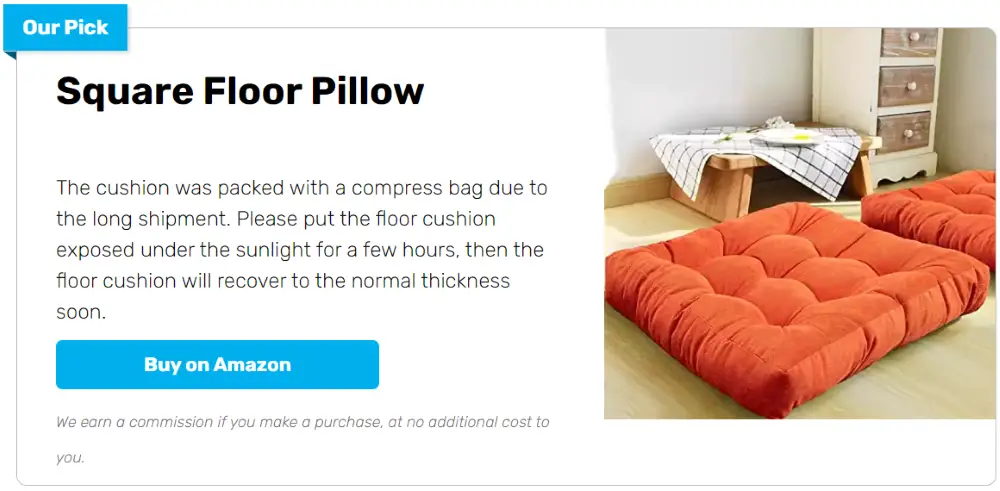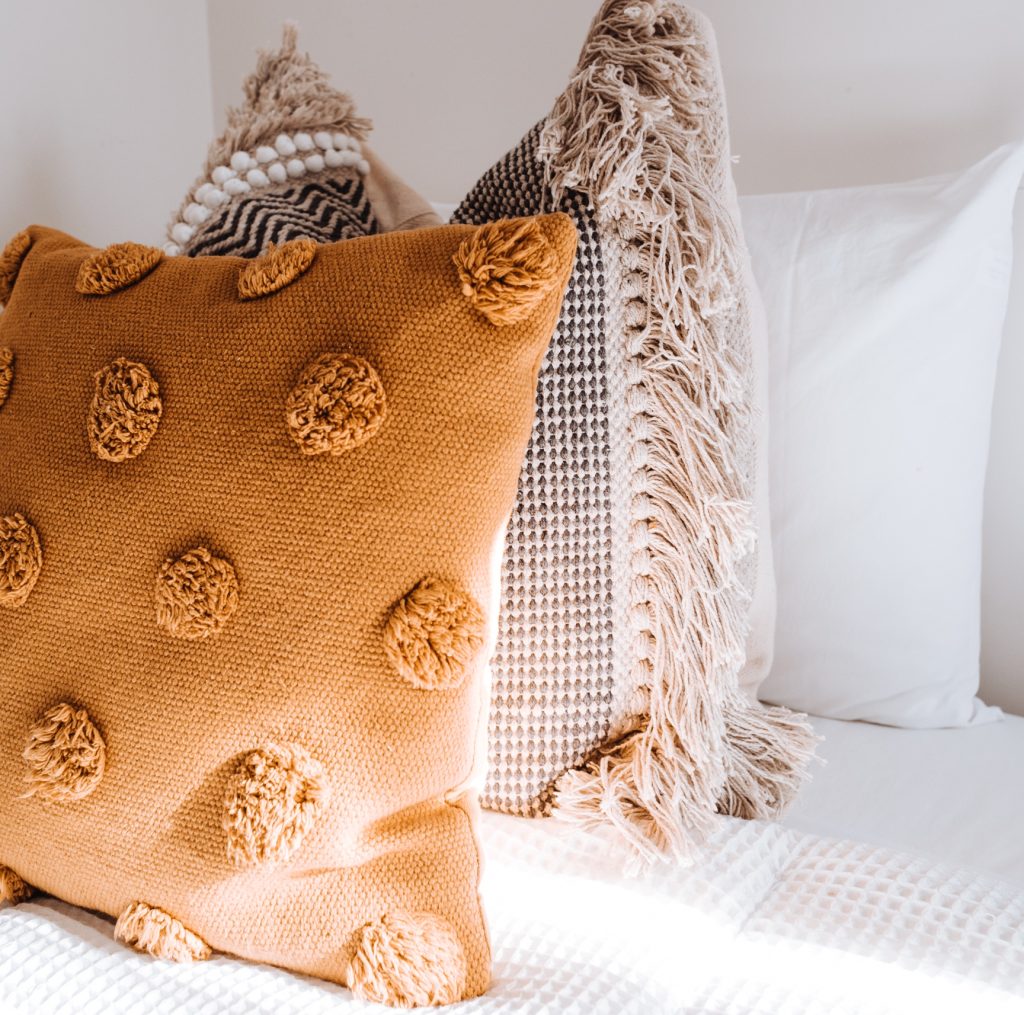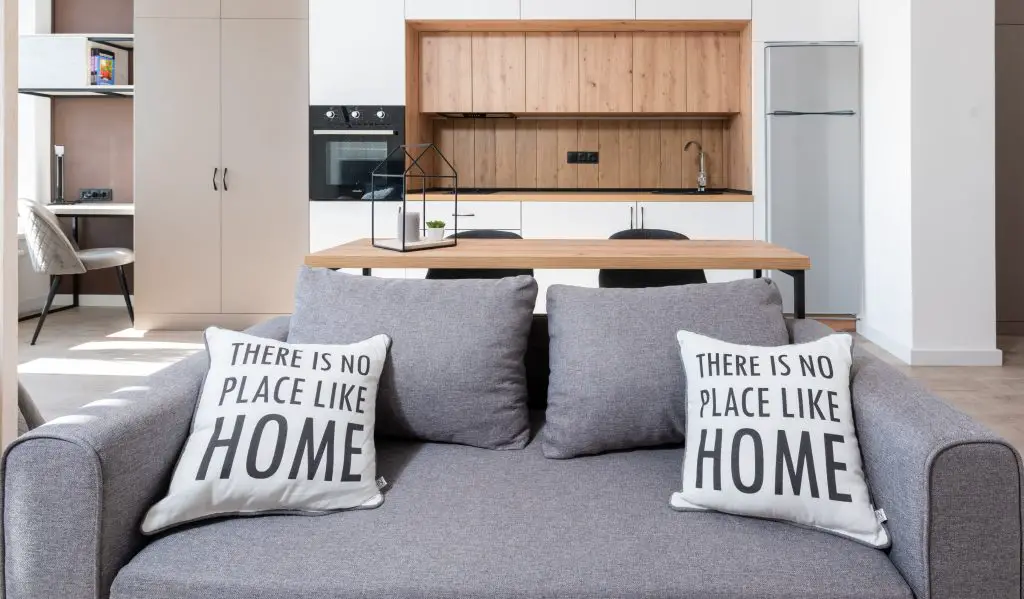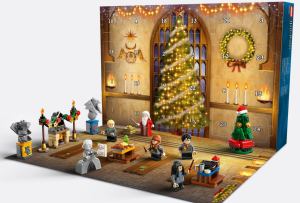Last Updated on March 11, 2024 by Team Ideas24
Decorative pillow covers are an excellent way to add a personalized touch to any living space. They add colour and texture and inject personality and character into a room. In this blog post, we will explore some of the most creative and stylish DIY decorative pillow covers that are easy to make and will elevate the décor of any room.
Whether you prefer modern, bohemian, or farmhouse decor, there is a pillow cover design that will complement your style. This blog post will offer step-by-step instructions and helpful tips to guide you through the process of creating your pillow covers. From fabric selection to embellishments, we will cover everything you need to know to create custom-made pillow covers that meet your unique style and preferences.
Contents
8 DIY Decorative Pillow Covers Ideas
Discover creative ways to repurpose old clothing, curtains, or table runners to create affordable DIY decorative pillow covers. These DIY pillow covers are perfect for refreshing your space without spending a lot of money.

Discover eight creative and inspiring ways to make your decorative pillow covers with these DIY ideas. From elegant and sophisticated to fun and playful, these pillow cover designs will add a personalized touch to your home decor.
1. Stenciled with Designs
DIY decorative pillow covers are an affordable way to transform the look of your living space. One creative idea to make your plain pillow covers unique is to use stencils. You can purchase pre-made stencils from craft stores or make your own with cardboard or acetate sheets.

To start, secure your pillow cover in place and place the stencil over it. Use tape to secure the stencil. Next, choose your paint colour and apply it over the stencil with a foam brush. Be sure to dab the brush gently to prevent bleeding under the stencil. Once you’ve painted the desired area, carefully remove the stencil and let the paint dry.
You can repeat this process with different stencils and colours to create a variety of designs on your DIY decorative pillow covers.
2. Fabric Painted Pillow Covers
One creative and unique way to design your DIY decorative pillow covers is to use fabric paint to create hand-painted designs on the covers. This is an affordable and enjoyable way to bring personal style and originality to your pillow covers. You can create any design you desire, from simple geometric shapes to more intricate floral or abstract patterns.
To get started, choose a colour palette that complements your decor and select high-quality fabric paint that will adhere well to the material of your covers. Then, use a small brush or sponge to apply the paint to the desired design. Let the paint dry before using the covers.
This technique provides endless possibilities for customizing your pillow covers, making them perfect for any room or style.

3. Pillow Covers With Patches, Buttons, or Beads
Adding small embellishments to DIY decorative pillow covers can transform the look of a plain pillow into a statement piece. One simple way to add a touch of personality is by sewing on patches, buttons, or beads. Patches can be bought in a range of designs, from florals to geometric shapes, and can be placed strategically on the cover.
Buttons of different sizes and colours can be sewn onto the corners or centre of the pillow as a subtle accent. Beads can be individually sewn in a pattern to create a unique design that complements the existing decor.
These small additions can be easily applied using a basic sewing kit and can add a personal touch to your DIY decorative pillow covers.
4. Embroidered Pillow Covers

Add some texture and dimension to your pillow covers with embroidery. It is a versatile craft that allows you to create a wide range of designs using colourful threads. Floral designs are one of the most popular options for embroidery, as they can add a beautiful and intricate touch to any pillow cover. When creating a floral design, you can choose from a variety of flowers, such as roses, daisies, sunflowers, or any flower that you like.
Simple geometric patterns are also great designs, such as triangles or squares, which can be used to create a modern and stylish look on your DIY pillow beds or couches. You can use different colours of thread to create contrast and add dimension.
You can use embroidery to add words or phrases to your pillow covers. This can be a great way to personalize your home decor or add a meaningful message. You can use a variety of fonts and colours to create the perfect look.
There are a lot of embroidery designs that you can use to make beautiful and unique DIY decorative pillow covers.
5. Iron-on Transfer Pillow Covers
One of the most creative ways to personalize your DIY decorative pillow covers is to use iron-on transfers to add custom designs or quotes to the covers. This method allows you to give a personal touch to your plain, boring cushion covers without spending too much time or effort. Iron-on transfers are readily available at most craft stores or online retailers.
You can choose from a range of designs or create your own, using graphics software or free design tools available online. Once your design is ready, print it onto iron-on transfer paper, and then transfer the design onto the pillow cover with the help of an iron.
Make sure to follow the instructions that come with your transfer paper and iron-on materials to avoid any damage or smudging. This method of customization can help you create unique, inspiring, and stylish DIY decorative pillow covers for your home or as personalized gifts for loved ones.

6. Layered Fabrics Pillow Covers
Layered fabrics are one of the easiest and most creative ways of making DIY decorative pillow covers. This technique uses different textures and patterns to create a dimensional effect on your pillow covers. For instance, mixing and matching materials like faux fur, velvet, cotton, and linen creates an eye-catching and unique design.
You can layer used fabrics differently, such as creating geometric shapes or overlapping patterns to add depth to your pillows. Layered fabrics also allow you to play around with colours, shapes, and sizes to create any desired style.
This project is perfect for those who want to add a touch of elegance and sophistication to their home décor. It’s also an inexpensive option when you want to make beautiful and unique DIY decorative pillow covers.
7. Pillow Covers With Pom-Poms, Tassels, or Fringes

If you want to add some flare to your DIY decorative pillow covers, consider incorporating playful textures like pom-poms, tassels, or fringes. These simple additions can make a big impact and give your covers a fun and unique touch.
Pom-poms can be easily sewn onto the corners or edges of your covers, adding a whimsical touch that elevates the design. Tassels can embellish the seams or corners of your covers, while fringes can create a bohemian vibe that adds depth and dimension.
Small details can take your pillow covers from ordinary to extraordinary, making them a great decorative element for any room in your home.
8. Pillow Covers With Pleats, Ruffles, or Gathers
If you’re looking for a way to elevate the style of your DIY decorative pillow covers, try using a sewing machine to create pleats, ruffles, or gathers. These techniques can transform your pillow covers from simple and plain to unique and eye-catching.
Pleats are created by reversing and sewing the fabric, resulting in a structured and orderly look. Ruffles involve gathering the fabric and sewing it onto the pillow cover, creating a soft and flowing effect. Gathers involve pulling the fabric together in a controlled manner and sewing it, producing a more tailored and refined appearance.
Whichever method you choose, using a sewing machine with a straight or zigzag stitch can make the process easy and quick, allowing you to achieve beautifully decorative and personalized pillow covers for your home.
Choosing the Right Fabric for Your Project
Creating DIY decorative pillow covers is an excellent way to add a personalized touch to any room. The fabric you choose determines your pillow covers’ look, feel, and durability. With many options available, selecting the right fabric can be overwhelming.
This guide will help you navigate through the choices to find the perfect fabric for your DIY decorative pillow covers, ensuring they complement your decor and stand the test of time.
Consider the Purpose
Before diving into fabric types, think about the primary function of your decorative pillow covers. Will they adorn a rarely-used guest room bed or be part of your daily living room setup, potentially facing more wear and tear? For high-traffic areas, opt for durable fabrics like canvas or denim, which can withstand regular use without losing their appeal.
Fabric Types and Textures
- Cotton: A versatile choice, cotton is available in a vast range of colors and patterns. It’s ideal for DIY decorative pillow covers due to its softness, durability, and ease of care. Cotton blends, which combine cotton with synthetic fibers, offer even more durability and resistance to wrinkling.
- Linen: Known for its natural, rustic look, linen brings an elegant and airy feel to pillow covers. It’s highly durable and even gets softer with each wash. However, linen can wrinkle and shrink, so it might require a bit more care.
- Velvet: For a touch of luxury and depth, velvet is unbeatable. It’s soft and has a unique texture that reflects light, giving your pillow covers a dynamic look. Velvet is suitable for both traditional and modern decor styles, but it can be a bit more challenging to sew due to its thickness.
- Silk and Satin: These materials add a sleek and smooth texture to pillow covers, perfect for adding a sophisticated touch to bedrooms or formal living rooms. They require gentle care and are more susceptible to damage from spills and stains.
- Outdoor Fabrics: Consider specialty outdoor fabrics if your pillow covers are destined for outdoor use. These are designed to resist fading, moisture, and mildew, making them perfect for patios or garden benches.
Color and Pattern
Choosing the right color and pattern ensures your DIY decorative pillow covers perfectly accent your existing decor. Consider the room’s color scheme and theme when selecting your fabric. Bold and vibrant prints can add a pop of color to a neutral space, while subtle patterns or solid colors might be better for a room with already busy decor.
Durability and Care
The longevity of your decorative pillow covers depends on the fabric’s durability and how easy it is to care for. Look for machine washable fabrics resistant to fading, especially if they will be used frequently or placed in areas exposed to sunlight. Pre-washing your fabric before sewing can also prevent future shrinkage and ensure your pillow covers maintain their shape and size.
Environmental Consideration
Organic fabrics like organic cotton, hemp, and bamboo are eco-friendly for those mindful of sustainability. These fabrics not only reduce the environmental impact but also offer durability and comfort, making them ideal for DIY decorative pillow covers.
Choosing the right fabric for your DIY decorative pillow covers is about balancing aesthetics with practicality. By considering the purpose, type, color, durability, and environmental impact of your fabric, you can create beautiful, durable, and environmentally friendly pillow covers that enhance your home decor and reflect your personal style.
Sewing Techniques for Beginners
Embarking on your first DIY decorative pillow cover project is an exciting journey into crafting and creativity. However, for those new to sewing, the process might seem daunting. Fear not, as mastering a few basic sewing techniques can turn you from a novice into a confident creator.
This guide focuses on foundational sewing skills tailored for beginners, ensuring your DIY decorative pillow covers look professional and last through many cozy sessions.
Getting Started
Familiarize yourself with your sewing machine, focusing on threading it, selecting different stitches, and adjusting tension. Practicing on scrap fabric can help you get comfortable before you start on your pillow covers.
Learn the basics of hand sewing for finishing touches or repairs. Key stitches include the running stitch, backstitch, and slip stitch, all useful for closing the opening of your pillow cover after inserting the pillow form.
Cutting and Measuring Fabric
Accurate measurements are crucial for DIY decorative pillow covers. Use a clear ruler, a fabric marker, and a cutting mat to ensure straight cuts and accurate dimensions. Remember to account for seam allowances in your measurements—usually about ½ inch on each side.
Understanding fabric grain is essential for ensuring your pillow cover looks and functions its best. Always cut your fabric so that the grain line runs parallel to the selvage, preventing your finished product from twisting or warping.
Basic Stitches
The backbone of sewing, a straight stitch, is used for most seams. Practice sewing straight and at a consistent seam allowance to ensure your pillow covers look neat and professional.
Useful for finishing raw edges to prevent fraying, a zigzag stitch can be particularly helpful if you don’t have a serger. It’s also great for sewing stretch fabrics.
A hand-sewing must-know, the backstitch is strong and durable, perfect for securing the opening of your pillow cover after inserting the pillow form.
Sewing Your Pillow Cover
Begin by sewing the sides of your DIY decorative pillow covers, keeping the fabric’s right sides together to hide the seams inside. Use pins or clips to hold the fabric in place as you sew.
Reduce the bulk by trimming the seam allowance at the corners for sharp and professional-looking corners. Be careful not to cut too close to your stitches. Turn the cover right side out and use a pointed tool (like a chopstick) to push out the corners gently.
After inserting the pillow form, use a ladder stitch (invisible stitch) to hand-sew the opening closed. This stitch is excellent for creating a seamless look and appearing like there was never an opening.
Practice Makes Perfect
Practice these techniques on scrap fabric before starting on your DIY decorative pillow covers. Experiment with different stitch lengths, tensions, and fabric types to see what works best for you.
Remember, mastering sewing takes time and patience. Don’t be discouraged by mistakes; they’re a part of the learning process. Each project you complete will increase your confidence and skill level.
Creating DIY decorative pillow covers as a beginner may seem challenging, but it’s a rewarding and fun way to learn sewing. By understanding your tools, mastering basic sewing techniques, and practicing, you’ll soon make beautiful pillow covers that add a personalized touch to your home. Remember, every stitch you make brings you one step closer to becoming a skilled crafter.
Wrapping It Up
To wrap up, DIY decorative pillow covers are a great way to add some personal style to your home decor. By following these design ideas and techniques, you can get your creativity flowing and create a unique and stylish accessory for your living space.
Not only is it a fun and enjoyable activity, but it’s also a cost-effective way to update the look of your home. Whether you’re looking to add some colour or patterns, or simply spruce up your old pillows, the choices are in a wide range.
You have learned eight stunning ideas that can transform a plain pillow into a work of art. From designing intricate stencils to layering different fabrics, these ideas offer a range of options to suit your style.
With your unique choice of fabric, thread, and embellishments, you can create beautiful DIY decorative pillow covers that will enhance the look and feel of your living room, bedroom, or any other space in your home. Ready to try making one?






